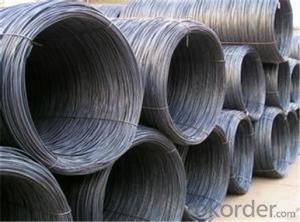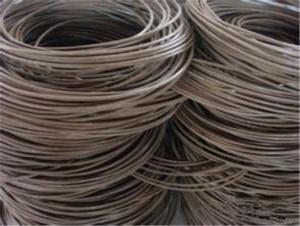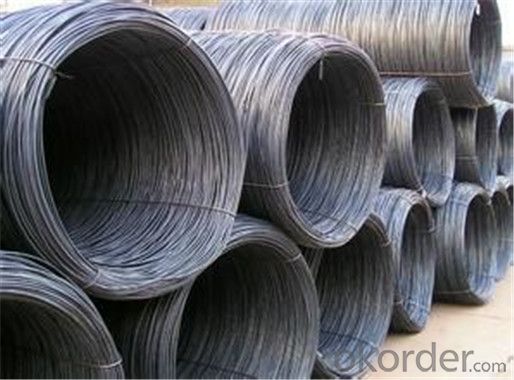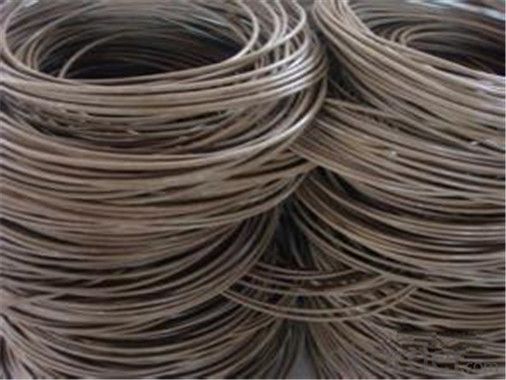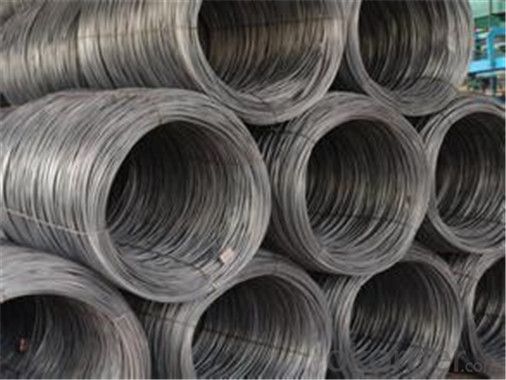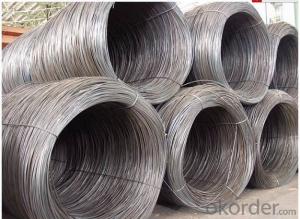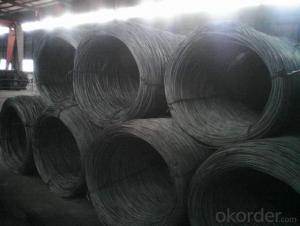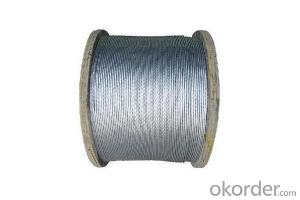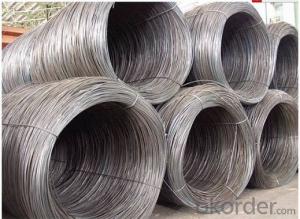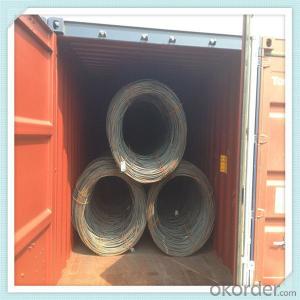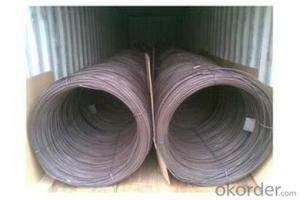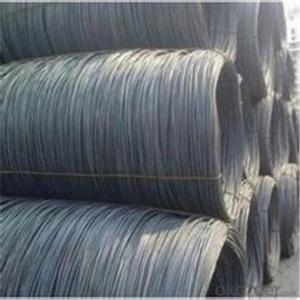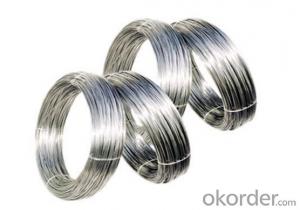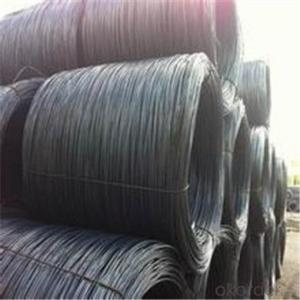SAE1006B Steel Wire Rod 5.5mm with Best Quality in China
- Loading Port:
- Tianjin
- Payment Terms:
- TT OR LC
- Min Order Qty:
- 200 m.t.
- Supply Capability:
- 45555555 m.t./month
OKorder Service Pledge
OKorder Financial Service
You Might Also Like
Specification
Description of wire Rod:
1. Drawn wire specialist, your wire rod solution
2. ISO9001 Certified Mill &SGS
3. Feature: machinability, high hardness, toughness, corrosion resistant
4. Clear and smooth surface, high precision and Tolerance control: ± 0.01
5. Customized service for your special requirement
6. Reasonable and more competitive mill price for you.
Festures of wire Rod:
1. Drawn wire specialist, your wire rod solution
2. ISO9001 Certified Mill &SGS
3. Feature: machinability, high hardness, toughness, corrosion resistant
4. Clear and smooth surface, high precision and Tolerance control: ± 0.01
5. Customized service for your special requirement
6. Reasonable and more competitive mill price for you.
Specifications of wire Rod:
Product | steel wire rod |
Standard | AISI, ASTM, BS, DIN, GB, JIS |
Material/steel grade | Q195-Q235,SAE1006, SAE1008, SAE1010, SAE1018, SAE1020 or according to customers requirements |
Wire Gauge | 5.5-12mm |
Coil weight | 1.8-2.1mts |
MOQ | 25MT |
Delivery Time | 15-30 days after receipt of L/C or deposit by T/T |
Packing | In coil and load in container, if large quantity, by bulk vessel; Can be packed as customers' special requirements |
Payment terms | 1).100% irrevocable L/C at sight. |
Application | widely used in machinery parts, manufacturing industry, electronics industry, metal tools and others |
Images of wire Rod:
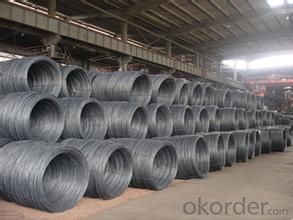
FAQ:
1. What is your package?
Packing situation: standard seaworthy packing or as customer required.
2. How long is the lead time?
Delivery time: 45 days after order confirmed.
3. What payment term do you accept?
Payment: T/T or L/C at sight.
- Q: How is steel wire rod used in the manufacturing of wire forms for signage?
- Wire forms for signage rely heavily on steel wire rod as a crucial element in their manufacturing process. The wire rod serves as the primary material for shaping and designing wire forms. To begin with, careful selection of the steel wire rod is based on its specific mechanical and chemical properties, such as tensile strength and resistance to corrosion. These properties guarantee the durability and ability of the wire forms made from the rod to withstand diverse weather conditions. Following the selection, the steel wire rod undergoes a series of manufacturing steps. Typically, the rod is drawn through a sequence of dies to reduce its diameter and increase its length. This wire drawing process enables the production of wires with precise dimensions and smooth surfaces. After achieving the desired thickness, the wire is further processed to create the specific shapes and forms required for signage. This may involve bending, coiling, or welding the wire into various configurations, depending on the design specifications. Once the wire forms are shaped using the steel wire rod, they are utilized in the manufacturing of signage. These wire forms often function as structural frameworks or supports for different types of signage, such as letters, logos, or decorative elements. They provide the necessary stability and rigidity to hold the signage in place, ensuring its integrity and visibility. Furthermore, the versatility of steel wire rod allows for the creation of intricate and complex wire forms that can be customized to meet specific design requirements. This design flexibility enables the production of visually captivating and distinctive signage, enhancing its aesthetic appeal and brand recognition. In conclusion, steel wire rod plays a vital role in the manufacturing of wire forms for signage. It serves as the raw material from which wire forms are shaped, providing the necessary strength and durability required for signage applications. The ability to customize wire forms allows for the creation of visually appealing and distinctive signage, making steel wire rod an indispensable component in the signage industry.
- Q: What are the different types of wire rods for reinforcement made from steel wire rod?
- There are several different types of wire rods for reinforcement made from steel wire rod, including plain wire rods, deformed wire rods, and cold-drawn wire rods. Plain wire rods are smooth and have no surface deformations, while deformed wire rods have ridges or bumps along their surface to provide better grip and adhesion with concrete. Cold-drawn wire rods are manufactured through a process of drawing the wire through a series of dies, resulting in a smoother and more uniform product with enhanced strength and flexibility.
- Q: What are the common packaging methods for steel wire rod?
- The common packaging methods for steel wire rod include coiling the rod into large coils, bundling the rod into smaller bundles, or spooling the rod onto a reel.
- Q: What are the different types of wire drawing dies used for steel wire rod?
- There are typically two types of wire drawing dies used for steel wire rods: tungsten carbide dies and diamond dies. Tungsten carbide dies are commonly used for drawing steel wire rods with larger diameters, while diamond dies are used for finer wire diameters. These dies help in shaping and reducing the diameter of the wire rods during the drawing process, resulting in a smoother surface finish and improved mechanical properties.
- Q: What are the common packaging materials used for steel wire rod coils?
- The common packaging materials used for steel wire rod coils include wooden pallets, steel strapping, plastic wrapping, and metal sheets. Wooden pallets are often used as a base to stack and store the coils, providing stability and easy handling during transportation. Steel strapping is used to secure the coils tightly together, preventing any movement or damage during transit. Plastic wrapping is commonly used to provide additional protection against moisture and dust, ensuring the coils remain in optimal condition. Metal sheets are sometimes placed on top of the coils to provide extra protection and prevent any external damage. These packaging materials are essential for ensuring the safe and efficient handling, storage, and transportation of steel wire rod coils.
- Q: How are steel wire rods used in the manufacturing of electrical conductors?
- Steel wire rods are used in the manufacturing of electrical conductors by being drawn into thin wires, which are then used to create the core of the conductor. The steel wire rods provide strength and durability to the conductor, ensuring it can carry electrical current efficiently and safely.
- Q: How is steel wire rod used in the manufacturing of wire forms for automotive suspension systems?
- Steel wire rod is an essential component in the manufacturing of wire forms for automotive suspension systems. The wire rod is typically made from high-grade steel and undergoes a series of processes to ensure its strength and durability. Firstly, the steel wire rod is heated and then passed through a series of rollers to reduce its diameter to the desired size. This process is known as wire drawing and helps to improve the wire's surface finish and mechanical properties. Once the wire rod is drawn to the required diameter, it is further processed to enhance its strength and flexibility. This is achieved through a process called heat treatment, where the wire is heated to a specific temperature and then rapidly cooled. This treatment helps to align the steel's crystalline structure, resulting in increased tensile strength and improved ductility. The wire forms used in automotive suspension systems are typically made by bending and shaping the steel wire rod. These wire forms play a crucial role in providing stability and support to the suspension system, allowing it to absorb shocks and vibrations while maintaining the vehicle's balance and ride comfort. The wire forms are used in various suspension components, such as coil springs, torsion bars, stabilizer bars, and control arms. For example, coil springs are made by winding the steel wire rod into a helical shape, which provides the necessary elasticity to absorb and distribute the forces acting on the suspension system. Similarly, torsion bars are made by twisting the steel wire rod, creating a resilient bar that can resist twisting forces. Stabilizer bars, also known as anti-roll bars, are made by bending the wire rod into a U or S shape and then attaching it to the vehicle's suspension system. These bars help to reduce body roll during cornering, improving the vehicle's stability and handling. Furthermore, control arms, which connect the suspension system to the vehicle's chassis, are often made using steel wire rod. These components must be strong and rigid to support the weight of the vehicle and withstand the various forces encountered during driving. In summary, steel wire rod is a crucial material in the manufacturing of wire forms for automotive suspension systems. Its strength, durability, and versatility make it ideal for producing various suspension components that play a vital role in ensuring a smooth and controlled ride for vehicles.
- Q: What are the weight requirements for steel wire rod coils?
- Weight requirements for steel wire rod coils can differ based on the specific application and industry standards. Generally, the weight of these coils can range from a few hundred kilograms to several metric tons. Determining the exact weight requirements depends on factors like the intended use of the wire rod, the type and grade of steel used, and the transportation and handling capabilities of the facilities involved. It is crucial to refer to the relevant industry standards and specifications to guarantee compliance with weight requirements for steel wire rod coils in a specific application.
- Q: What are the common production processes for zinc-coated steel wire rod?
- The common production processes for zinc-coated steel wire rod include cleaning and pickling the steel wire rod, coating it with a layer of zinc through hot-dip galvanizing or electro-galvanizing, and finally, coiling the zinc-coated wire rod for packaging and transportation.
- Q: How is steel wire rod used in the manufacturing of window and door frames?
- Steel wire rod is used in the manufacturing of window and door frames to provide strength, durability, and stability to the frames. It is commonly used to reinforce the corners and joints of the frames, ensuring they can withstand the weight and pressure placed on them. Additionally, steel wire rod is often used as a support structure within the frames, helping to maintain their shape and prevent warping or bending over time.
Send your message to us
SAE1006B Steel Wire Rod 5.5mm with Best Quality in China
- Loading Port:
- Tianjin
- Payment Terms:
- TT OR LC
- Min Order Qty:
- 200 m.t.
- Supply Capability:
- 45555555 m.t./month
OKorder Service Pledge
OKorder Financial Service
Similar products
Hot products
Hot Searches
Related keywords
